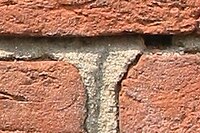
Photo from wikipedia
Abstract The paper includes a case study of modelling a real historic church using the finite element method (FEM) based on laser scans of its geometry. The main goal of… Click to show full abstract
Abstract The paper includes a case study of modelling a real historic church using the finite element method (FEM) based on laser scans of its geometry. The main goal of the study was the analysis of the causes of cracking and crushing of masonry walls. An FEM model of the structure has been defined in ABAQUS. A non-linear dynamic explicit analysis with material model including damage plasticity has been performed. A homogenization procedure has been applied to obtain the material parameters used in the modelling of masonry. In the numerical analysis, the interactions between the church structure, the foundations and the ground were taken into account. The obtained results match well with the damaged area of the entire structure from the in situ survey, and it should be highlighted that the proposed FEM model allows for a rather precise identification of the causes and effects of cracking walls in a qualitative sense. Also a brief research summary is presented.
Journal Title: Engineering Failure Analysis
Year Published: 2020
Link to full text (if available)
Share on Social Media: Sign Up to like & get
recommendations!